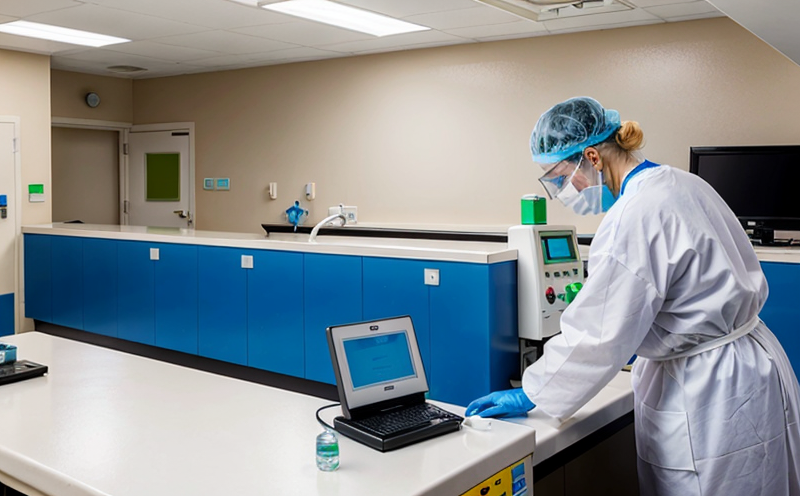Air Quality Monitoring for Aspergillus spp. in Surgical Suites
The importance of maintaining optimal air quality within surgical suites cannot be overstated. Poor air quality can lead to increased risk of post-operative infections, which is particularly concerning given the presence of opportunistic pathogens like Aspergillus species.
Aspergillus spp., a common mold found in various environments, poses significant health risks when present in hospital settings. In immunocompromised patients and those undergoing surgical procedures, exposure to airborne spores can result in invasive aspergillosis, a potentially fatal condition. Therefore, air quality monitoring for Aspergillus spp. in surgical suites is critical.
Airborne sampling methods such as settle plates and impingers are typically used to detect the presence of Aspergillus spp. These tests involve collecting airborne particles on agar media over a specific period before incubation and identification. However, these methods can be labor-intensive and may not provide real-time data.
Advanced air quality monitoring systems offer continuous monitoring capabilities, providing detailed information about spore concentrations in the air. Such systems often use laser particle counters or other sensor technologies to measure particulate matter at various points within the surgical suite. This approach allows healthcare facilities to identify potential hotspots and take proactive measures to mitigate risks.
When selecting an appropriate monitoring system, it is essential to consider factors such as sensitivity, specificity, and ease of use. Compliance with international standards like ISO 14644-3 ensures that the equipment used meets stringent requirements for cleanroom environments. Additionally, regular calibration and maintenance schedules should be established to ensure accurate results.
Healthcare facilities must also establish clear protocols for interpreting monitoring data and responding accordingly. This includes setting target limits based on risk assessment outcomes and defining corrective actions when thresholds are exceeded. By implementing robust air quality management practices, hospitals can significantly reduce the likelihood of Aspergillus spp.-related incidents.
Real-world examples highlight the effectiveness of these measures. For instance, a leading academic medical center implemented an aggressive air quality monitoring program following several cases of invasive aspergillosis among patients who had undergone heart valve replacement surgery. After introducing continuous monitoring and targeted interventions, they observed a dramatic reduction in both spore counts and associated infections.
In conclusion, comprehensive air quality monitoring for Aspergillus spp. is an indispensable tool for maintaining sterile conditions within surgical suites. It enables healthcare providers to identify and address potential issues promptly, thereby enhancing patient safety and operational efficiency.
Why Choose This Test
Choosing air quality monitoring for Aspergillus spp. in surgical suites offers numerous advantages that cater specifically to the needs of healthcare facilities. Firstly, it provides critical insights into environmental conditions that could impact patient outcomes directly. Secondly, by identifying high-risk areas early on, hospitals can implement targeted interventions more effectively.
- Enhanced Patient Safety: Reduces the risk of hospital-acquired infections linked to Aspergillus spp.
- Improved Operational Efficiency: Allows for timely adjustments in cleaning and maintenance schedules.
- Compliance with Standards: Ensures adherence to international guidelines such as ISO 14644-3.
- Data-Driven Decisions: Offers actionable intelligence based on real-time monitoring data.
The reliability and accuracy of the test are further bolstered by advanced instrumentation capable of detecting even trace levels of Aspergillus spp. Specimen preparation is straightforward, involving collection onto appropriate media followed by incubation periods typically lasting 48 hours or longer depending on specific requirements.
Healthcare professionals benefit from easy-to-understand reports that summarize findings and suggest next steps. Continuous monitoring ensures sustained compliance with best practices throughout the entire surgical suite lifecycle. This proactive approach not only protects patients but also supports the facility’s reputation for excellence in infection control measures.
International Acceptance and Recognition
- ISO 14644-3: International Organization for Standardization standard that specifies the requirements for air cleanliness classification in cleanrooms and associated controlled environments.
- American Society for Testing and Materials (ASTM): ASTM E2708 provides guidance on methods of sampling and enumeration of fungi in indoor air.
- British Standards Institution (BSI): BS EN ISO 14644-3 is widely recognized across Europe for defining criteria related to airborne contaminants within healthcare settings.
The widespread adoption of these standards underscores the global consensus on the necessity and benefits of air quality monitoring in surgical suites. Compliance with such internationally accepted protocols not only enhances credibility but also facilitates easier collaboration between different healthcare institutions worldwide.
Competitive Advantage and Market Impact
In today’s competitive healthcare landscape, maintaining a reputation for excellence in infection control is paramount. Hospitals that invest in advanced air quality monitoring systems stand to gain several strategic advantages:
- Innovation Leaders: Early adoption of cutting-edge technologies positions facilities as leaders in innovation.
- Patient Trust: Demonstrating commitment to patient safety fosters trust among stakeholders and the public.
- Recruitment Opportunities: Attract top-tier talent attracted by a culture focused on quality and continuous improvement.
The ability to offer comprehensive monitoring services also expands service offerings, potentially opening up new revenue streams. Additionally, participation in industry forums and collaborative research projects enhances visibility within the professional community. Ultimately, these initiatives contribute significantly to long-term sustainability and growth for healthcare providers.





